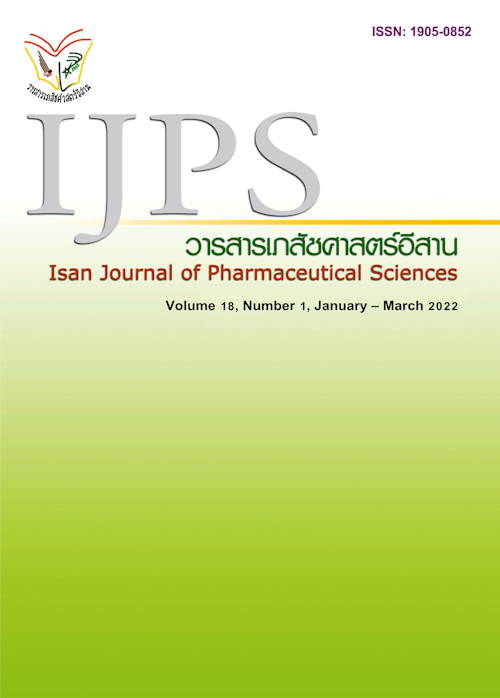Evaluation of Quality of Life from Chemotherapy Induced Peripheral Neuropathy in Solid Cancer Patients
Main Article Content
Abstract
Peripheral neuropathy is a common adverse drug reaction following treatment with chemotherapy. This adverse drug reaction and its severity affect treatment efficacy and quality of life of cancer patients. The study objective was to compare the quality of life scores change from chemotherapy-induced peripheral neuropathy between low severity group (grade 0-1) and moderate severity or higher group (grade 2 or higher). Materials and Method: The prospective cohort study was conducted in solid tumors patients who received chemotherapy at the chemotherapy patient care unit, Sunpasitthiprasong Hospital, Ubon Ratchathani Province from 1 August 2020 to 31 January 2021. The Quality of Life Questionnaire-Chemotherapy-Induced Peripheral Neuropathy Thai version (EORTC QLQ-CIPN20) was used for the evaluation of peripheral neuropathy related quality of life. Common Terminology Criteria for Adverse Events (CTCAE version 5.0) was used for assessing peripheral neuropathy severity. Comparing change of quality of life between between low severity group and moderate severity or higher group peripheral neuropathy using Mann –Whitney U-test. Results: Seventy patients were enrolled. Forty-seven patients (67.14%) had peripheral neuropathy. Sensory neuropathy was reported majorly type in 41 patients (58.57%) and 12 patients (29.27%) had moderate severity or higher. The median overall quality of life score change was significantly increased in moderate severity or higher (12.22 (Interquartile rang 11.11)) compared with low severity group (3.33 (Interquartile rang 6.67)) (P-value < 0.001). The change in sensory quality of life and motor quality of life score were also significantly increased in moderate severity or higher group. Thus, Conclusion: peripheral neuropathy has high severity after chemotherapy treatment, and resulting poorer quality of life.
Article Details

This work is licensed under a Creative Commons Attribution-NonCommercial-NoDerivatives 4.0 International License.
In the case that some parts are used by others The author must Confirm that obtaining permission to use some of the original authors. And must attach evidence That the permission has been included
References
André T, Boni C, Mounedji-Boudiaf L, Navarro M, Tabernero J, Hickish T, et al. Oxaliplatin, fluorouracil, and leucovorin as adjuvant treatment for colon cancer. New England Journal of Medicine. 2004;350(23):2343-51.
Aoki Y, Watanabe M, Amikura T, Obata H, Sekine M, Yahata T, et al. Adjuvant chemotherapy as treatment of high-risk stage I and II endometrial cancer. Gynecologic oncology. 2004;94(2):333-9.
Cavaletti G, Frigeni B, Lanzani F, Mattavelli L, Susani E, Alberti P, et al. Chemotherapy-induced peripheral neurotoxicity assessment: a critical revision of the currently available tools. European Journal of Cancer. 2010;46(3):479-94.
Common Terminology Criteria for Adverse Events (CTCAE) Version 5.0 [Internet]. 2017. Available from: https://ctep.cancer.gov/protocoldevelopment/ electronic_applications/docs/ctcae_v5_quick_reference_5x7.pdf.
DeVita VT, Lawrence TS, Rosenberg S. Cancer: Principles&Practice of Oncology. Philadephia: Lippincott Williams&Wilkins; 2008.
Eckhoff L, Knoop A, Jensen M, Ewertz M. Persistence of docetaxel-induced neuropathy and impact on quality of life among breast cancer survivors. European Journal of Cancer. 2015;51(3):292-300.
Johns NP. Health-related quality of life: Evaluation and implementation. Khon kaen: KKUPrinting House.; 2009.
Kautio A-L, Haanpää M, Kautiainen H, Kalso E, Saarto T. Burden of chemotherapy-induced neuropathy—a cross-sectional study. Supportive Care in Cancer. 2011;19(12):1991-6.
Lau PM, Stewart K, Dooley M. The ten most common adverse drug reactions (ADRs) in oncology patients: do they matter to you? Supportive care in cancer. 2004;12(9):626-33.
Miltenburg N, Boogerd W. Chemotherapy-induced neuropathy: a comprehensive survey. Cancer treatment reviews. 2014;40(7):872-82.
National Cancer Control Programme 2018-2022. In: National Cancer Prevention and Control Plan Committee, editor. 2018. p. 1-5.
Postma TJ, Aaronson N, Heimans J, Muller M, Hildebrand J, Delattre J-Y, et al. The development of an EORTC quality of life questionnaire to assess chemotherapy-induced peripheral neuropathy: the QLQ-CIPN20. European journal of cancer. 2005;41(8):1135-9.
Prasertsri N, Kaewmanee C, Khantichitr P, Teeyapan W, Smith EML, Wamalun C, et al. Chemotherapy-Induced Peripheral Neuropathy (CIPN): A Cross-Sectional Study in Cancer Patients. Journal of Nursing, Public Health, and Education (ISSN: 2651-1908 Journal Online). 2017;18(3):52-62.
Seretny M, Currie GL, Sena ES, Ramnarine S, Grant R, MacLeod MR, et al. Incidence, prevalence, and predictors of chemotherapy-induced peripheral neuropathy: a systematic review and meta-analysis. PAIN®. 2014;155(12):2461-70.
Slamon D, Eiermann W, Robert N, Pienkowski T, Martin M, Press M, et al. Adjuvant trastuzumab in HER2-positive breast cancer. New England Journal of Medicine. 2011;365(14):1273-83.
Soveri L, Lamminmäki A, Hänninen U, Karhunen M, Bono P, Osterlund P. Long-term neuropathy and quality of life in colorectal cancer patients treated with oxaliplatin containing adjuvant chemotherapy. Acta Oncologica. 2019;58(4):398-406.
Stubblefield MD, Burstein HJ, Burton AW, Custodio CM, Deng GE, Ho M, et al. NCCN task force report: management of neuropathy in cancer. Journal of the National Comprehensive Cancer Network. 2009;7(Suppl_5):S-1-S-26.
Subongkot S. Oncology Pharmacy Practice. In: Subongkot S, Sae-teaw M, Chanthawong S, editors. The min in the treatment of cancer. 1 ed. Khon Kaen: KKUPrinting House; 2013. p. 15-28.
Subongkot S. Oncology Pharmacy Practice. In: Subongkot S, Sae-teaw M, Chanthawong S, editors. The main in the treatment od cancer. 4 ed. Khon Kaen: KKUPrinting House.; 2018. p. 19-37.
Yeo F, Ng CC, Loh KW, Molassiotis A, Cheng HL, Au JS, et al. Minimal clinically important difference of the EORTC QLQ-CIPN20 for worsening peripheral neuropathy in patients receiving neurotoxic chemotherapy. Supportive care in cancer. 2019;27(12):4753-62.


